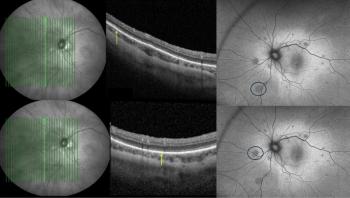
Post-hoc analyses of YOSEMITE/RHINE trials compare faricimab results to aflibercept
The YOSEMITE/RHINE studies measured changes in the BCVA and CST from baseline to years 1 and 2
Post-hoc subcohort analyses of patients with
Marco Zarbin, MD, PhD, FACS, first author of the recent study in Ophthalmology, is from the Institute of Ophthalmology and Visual Science, Rutgers New Jersey Medical School, Newark, NJ.
Zarbin and colleagues explained that the DRCR.net Protocol T suggested that the response to anti-vascular endothelial growth factor (VEGF) treatment among patients with DME may vary depending on the baseline BCVA,2,3 which was the rationale for the study under discussion. They compared the two treatments, faricimab 6 mg and aflibercept 2 mg, over 2 years in patients with DME in the Phase III trials. The patients had a BCVA of 20/50 or less; the treatment results in patients with that level of BCVA had not yet been reported.
The YOSEMITE/RHINE studies (NCT03622580 and NCT03622593) had identical designs, and were multicentre, randomised, double-masked, active comparator–controlled, noninferiority trials.
Patients were randomised to treatment with faricimab every 8 weeks (Q8W), faricimab according to a personalised treat-and-extend–based regimen (T&E), or aflibercept Q8W. The main outcome measures were the changes in the BCVA and central subfield thickness (CST) from baseline to years 1 and 2 that were compared among the treatment arms.
In the YOSEMITE and RHINE studies, the following respective numbers of patients in the three study arms had a baseline BCVA of 20/50 or less: 220/217 patients in the faricimab Q8W regimen; 220/219 in the faricimab T&E regimen; and 219/214 in the aflibercept Q8W regimen.
The investigators reported that the mean changes in the BCVA were comparable for both treatments at years 1 and 2. In the YOSEMITE study, the adjusted mean (95% confidence interval) decrease from baseline in the CST (in microns) at year 1 was greater with the faricimab Q8W (–232.8 [–243.5, –222.1]) and faricimab T&E regimens (–217.4 [–227.9, –206.9]) compared with aflibercept Q8W (–190.4 [–200.9, –179.8]; P<0.0001 and P=0.0004, respectively).
The authors reported similar findings in the RHINE study, ie, faricimab Q8W, –214.2 (–225.3, –203.1); faricimab T&E, –206.6 (–217.4, –195.7); aflibercept Q8W, –186.6 (–197.7, –175.5);P=0.0006 and P=0.0116 for faricimab arms versus aflibercept, respectively.
At the 2-year time point, the changes from baseline in the CST were greater with faricimab Q8W versus aflibercept in both studies.
The investigators observed that the median time to the first decrease in the CST below 325 microns and first absence of intraretinal fluid was shorter in the faricimab arms versus aflibercept. These results were achieved with a lower average number of injections of faricimab.
Zarbin and colleagues concluded, “The findings of these subcohort analyses of patients with DME and baseline ETDRS BCVA of 20/50 or less demonstrated that VEGF/angiopoietin-2 inhibition with faricimab achieved comparable changes in VA and greater anatomic improvement with fewer injections compared with anti-VEGF therapy with aflibercept over 2 years of treatment.”
References:
Zarbin M, Tabano D, Ahmed A, et al. Efficacy of faricimab vs aflibercept in diabetic macular edema in the 20/50 or worse vision subgroup in phase 3 YOSEMITE/RHINE Trials. Ophthalmology. 2024; published online June 8;
https://doi.org/10.1016/j.ophtha.2024.05.025 Cai S, Bressler NM. Aflibercept, bevacizumab or ranibizumab for diabetic macular oedema: recent clinically relevant findings from DRCR.net Protocol T. Curr Opin Ophthalmol. 2017;28:636-643;
https://doi.org/10.1097/icu.0000000000000424 Wells JA, Glassman AR, Ayala AR, et al. Aflibercept, bevacizumab, or ranibizumab for diabetic macular edema. N Engl J Med.2015; 372:1193-1203;
https://doi.org/10.1056/NEJMoa1414264
Newsletter
Get the essential updates shaping the future of pharma manufacturing and compliance—subscribe today to Pharmaceutical Technology and never miss a breakthrough.













































